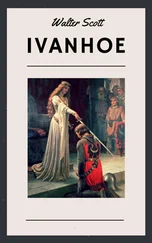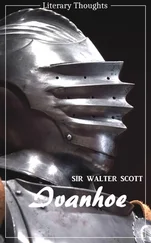‘I scarce can think him such a worthless thing,
Unless he praise some monster of a king;
Or virtue, or religion turn to sport,
To please a lewd, or unbelieving court.
Unhappy Dryden! In all Charles’s days,
Roscommon only boasts unspotted bays.’
line 283. Cp. Gray’s ‘Progress of Poesy,’ 103-
‘Behold, where Dryden’s less presumptuous car
Wide o’er the fields of glory bear
Two coursers of ethereal race,
With necks in thunder cloth’d, and long-resounding pace’;
and Pope’s ‘Satires and Epistles,’ v. 267-
‘Dryden taught to join
The varying verse, the full-resounding line,
The long majestic march, and energy divine.’
line 286. To break a lance is to enter the lists, to try one’s strength. The concussion of two powerful knights would suffice to shiver the lances. Hence comes the figurative use. Cp. I Henry VI. iii. 2,-
‘What will you do, good greybeard? break a lance,
And run a tilt at death within a chair?’
lines 288-309. The Genius of Chivalry is to be resuscitated from the deep slumber under which baneful spells have long effectually held him. The appropriateness of this is apparent when the true meaning of Chivalry is considered. Scott opens his ‘Essay on Chivalry’ thus:-’The primitive sense of this well-known word, derived from the French Chevalier , signifies merely cavalry, or a body of soldiers serving on horseback; and it has been used in that general acceptation by the best of our poets, ancient and modern, from Milton to Thomas Campbell.’ See Par. Lost, i. 307, and Battle of Hohenlinden.
line 294. To spur forward his horse on an expedition of adventures, like Spenser’s Red Cross Knight. For the accoutrements and the duties of a knight see Scott’s ‘Essay on Chivalry’ (Miscellaneous Works, vol. vi.). Cp. ‘Faery Queene,’ Book I, and (especially for the personified abstractions from line 300 onwards) Montgomerie’s allegory, ‘The Cherrie and the Slae.’
line 312. Ytene’s oaks. ‘The New Forest in Hampshire, anciently so called.’-SCOTT. Gundimore, the residence of W. S. Rose, was in this neighbourhood, and in an unpublished piece entitled ‘Gundimore,’ Rose thus alludes to a visit of Scott’s:-
‘Here Walter Scott has woo’d the northern muse;
Here he with me has joy’d to walk or cruise;
And hence has prick’d through Yten’s holt, where we
Have called to mind how under greenwood tree,
Pierced by the partner of his “woodland craft,”
King Rufus fell by Tyrrell’s random shaft.’
line 314. ‘The “History of Bevis of Hampton” is abridged by my friend Mr. George Ellis, with that liveliness which extracts amusement even out of the most rude and unpromising of our old tales of chivalry. Ascapart, a most important personage in the romance, is thus described in an extract:-
“This geaunt was mighty and strong,
And full thirty foot was long.
He was bristled like a sow;
A foot he had between each brow;
His lips were great, and hung aside;
His eyen were hollow, his mouth was wide;
Lothly he was to look on than,
And liker a devil than a man.
His staff was a young oak,
Hard and heavy was his stroke.”
Specimens of Metrical Romances , vol. ii. p. 136.
‘I am happy to say, that the memory of Sir Bevis is still fragrant in his town of Southampton; the gate of which is sentinelled by the effigies of that doughty knight errant and his gigantic associate.’-SCOTT.
The Introduction is written on a basis of regular four-beat couplets, each line being technically an iambic tetrameter; lines 96, 205, and 283 are Alexandrines, or iambic hexameters, each serving to give emphasis and resonance (like the ninth of the Spenserian stanza) to the passage which it closes. Intensity of expression is given by the triplet which closes the passage ending with line 125. The metrical basis of the movement in the Canto is likewise iambic tetrameter, but the trimeter or three-beat line is freely introduced, and the poet allows himself great scope in his arrangement.
Stanza I. line 1. ‘The ruinous castle of Norham (anciently called Ubbanford) is situated on the southern bank of the Tweed, about six miles above Berwick, and where that river is still the boundary between England and Scotland. The extent of its ruins, as well as its historical importance, shows it to have been a place of magnificence, as well as strength. Edward I resided there when he was created umpire of the dispute concerning the Scottish succession. It was repeatedly taken and retaken during the wars between England and Scotland; and, indeed, scarce any happened, in which it had not a principal share. Norham Castle is situated on a steep bank, which overhangs the river. The repeated sieges which the castle had sustained, rendered frequent repairs necessary. In 1164, it was almost rebuilt by Hugh Pudsey, Bishop of Durham, who added a huge keep, or donjon; notwithstanding which, King Henry II, in 1174, took the castle from the bishop, and committed the keeping of it to William de Neville. After this period it seems to have been chiefly garrisoned by the King, and considered as a royal fortress. The Greys of Chillinghame Castle were frequently the castellans, or captains of the garrison: Yet, as the castle was situated in the patrimony of St. Cuthbert, the property was in the see of Durham till the Reformation. After that period, it passed through various hands. At the union of the crowns, it was in the possession of Sir Robert Carey, (afterwards Earl of Monmouth,) for his own life, and that of two of his sons. After King James’s accession, Carey sold Norham Castle to George Home, Earl of Dunbar, for L6000. See his curious Memoirs, published by Mr. Constable of Edinburgh.
‘According to Mr. Pinkerton, there is, in the British Museum. Cal. B. 6. 216, a curious memoir of the Dacres on the state of Norham Castle in 1522, not long after the battle of Flodden. The inner ward, or keep, is represented as impregnable:-“The provisions are three great vats of salt eels, forty-four kine, three hogsheads of salted salmon, forty quarters of grain, besides many cows and four hundred sheep, lying under the castle-wall nightly; but a number of the arrows wanted feathers, and a good Fletcher [i.e. maker of arrows] was required.”- History of Scotland , vol. ii. p. 201, note.
‘The ruins of the castle are at present considerable, as well as picturesque. They consist of a large shattered tower, with many vaults, and fragments of other edifices, enclosed within an outward wall of great circuit.’-SCOTT.
line 4. battled= embattled, furnished with battlements. See Introd. to Canto V. line 90, and cp. Tennyson’s ‘Dream of Fair Women,’ line 220:-
‘The valleys of grape-loaded vines that glow
Beneath the battled tower .’
the donjon keep. ‘It is perhaps unnecessary to remind my readers, that the donjon , in its proper signification, means the strongest part of a feudal castle; a high square tower, with walls of tremendous thickness, situated in the centre of the other buildings, from which, however, it was usually detached. Here, in case of the outward defences being gained, the garrison retreated to make their last stand. The donjon contained the great hall, and principal rooms of state for solemn occasions, and also the prison of the fortress; from which last circumstance we derive the modern and restricted use of the word dungeon . Ducange ( voce DUNJO) conjectures plausibly, that the name is derived from these keeps being usually built upon a hill, which in Celtic is called DUN. Borlase supposes the word came from the darkness of the apartments in these towers, which were thence figuratively called Dungeons; thus deriving the ancient word from the modern application of it.’-SCOTT.
Читать дальше






